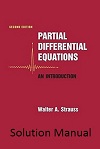MathSchoolinternational contain thousands of
Mathematics Free Books and
Physics Free Books. Which cover almost all topics for students of Mathematics, Physics and Engineering. We have also collected other
Best Free Math Websites for teachers and students.
for teachers and students.
Here is extisive list of
Differential Equations Books . We hope students and teachers like these textbooks, notes and solution manuals.
Share this page:-

Congratulations, the link is avaliable for free download.
About this book :-
Partial Differential Equations: An Introduction (Solutions Manual) written by
Walter A Strauss .
The second edition of Partial Differential Equations provides an introduction to the basic properties of PDEs and the ideas and techniques that have proven useful in analyzing them. It provides the student a broad perspective on the subject, illustrates the incredibly rich variety of phenomena encompassed by it, and imparts a working knowledge of the most important techniques of analysis of the solutions of the equations. In this book mathematical jargon is minimized. Our focus is on the three most classical PDEs, the wave, heat and Lapace equations. Advanced concepts are introduced frequently but with the least possible technicalities. The book is flexibly designed for juniors, seniors or beginning graduate students in science, engineering or mathematics.
This is an undergraduate textbook. It is designed for juniors and seniors who are science, engineering, or mathematics majors. Graduate students, especially in the sciences, could surely learn from it, but it is in noway conceived of as a graduate text.
Our understanding of the fundamental processes of the natural world is based to a large extent on partial differential equations. Examples are the vibrations of solids, the flow of fluids, the diffusion of chemicals, the spread of heat, the structure of molecules, the interactions of photons and electrons, and the radiation of electromagnetic waves. Partial differential equations also play a central role in modern mathematics, especially in geometry and analysis. The availability of powerful computers is gradually shifting the emphasis in partial differential equations away from the analytical computation of solutions and toward both their numerical analysis and the qualitative theory.
This book provides an introduction to the basic properties of partial differential equations (PDEs) and to the techniques that have proved useful in analyzing them. My purpose is to provide for the student a broad perspective on the subject, to illustrate the rich variety of phenomena encompassed by it, and to impart a working knowledge of the most important techniques of analysis of the solutions of the equations.
One of the most important techniques is the method of separation of variables. Many textbooks heavily emphasize this technique to the point of excluding other points of view. The problem with that approach is that only certain kinds of partial differential equations can be solved by it, whereas others cannot. In this book it plays a very important but not an overriding role. Other texts, which bring in relatively advanced theoretical ideas, require too much mathematical knowledge for the typical undergraduate student. The author has tried to minimize the advanced concepts and the mathematical jargon in this book. However, because partial differential equations is a subject at the forefront of research in modern science, I have not hesitated to mention advanced ideas as further topics for the ambitious student to pursue.
(Walter A Strauss)
Book Detail :-
Title: Partial Differential Equations: An Introduction (Solutions Manual)
Edition: 2nd
Author(s): Walter A Strauss
Publisher: Wiley
Series:
Year: 2007
Pages: 691
Type: PDF
Language: English
ISBN: 0470054565,9780470054567
Country: US
Download Similar Books from Amazon
About Author :-
The author Walter Alexander Strauss was born 1937, is American applied mathematician, specializing in partial differential equations and nonlinear waves.
Walter Strauss graduated in 1958 with an BA in mathematics from Columbia University and in 1959 with an MS from the University of Chicago. He received his Ph.D. from the Massachusetts Institute of Technology in 1962 with thesis Scattering for hyperbolic equations under the supervision of Irving Segal. Strauss was a postdoc for the academic year 1962–1963 at the Université de Paris. He was a visiting assistant professor from 1963 to 1966 at Stanford University. At Brown University he was an associate professor from 1966 to 1971 and a full professor from 1971 to the present.
Walter Strauss has done research on "scattering theory in electromagnetism and acoustics, stability of waves, relativistic Yang-Mills theory, kinetic theory of plasmas, theory of fluids, and water waves.
Join our new updates, alerts:-
For new updates and alerts join our WhatsApp Group and Telegram Group (you can also ask any [pdf] book/notes/solutions manual).
 Join WhatsApp Group
Join WhatsApp Group
 Join Telegram Group
Join Telegram Group
Book Contents :-
Partial Differential Equations: An Introduction (Solutions Manual) written by
Walter A Strauss
cover the following topics.
'
1. Where PDEs Come From
2. Waves and Diffusions
3. Reflections and Sources
4. Boundary Problems
5. Fourier Series
6. Harmonic Functions
7. Green’s Identities and Green’s Functions
8. Computation of Solutions
9. Waves in Space
10. Boundaries in the Plane and in Space
11. General Eigenvalue Problems
12. Distributions and Transforms
13. PDE Problems from Physics
14. Nonlinear PDEs
Appendix
References
Answers and Hints to Selected Exercises
Index
Note:-
We are not the owner of this book/notes. We provide it which is already avialable on the internet. For any further querries please contact us. We never SUPPORT PIRACY. This copy was provided for students who are financially troubled but want studeing to learn. If You Think This Materials Is Useful, Please get it legally from the PUBLISHERS. Thank you.
